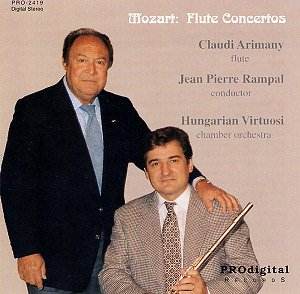|
|
Search MusicWeb Here |
|
 |
||
|
Founder:
Len Mullenger (1942-2025) Editor
in Chief:John Quinn
|
|
|
Search MusicWeb Here |
|
 |
||
|
Founder:
Len Mullenger (1942-2025) Editor
in Chief:John Quinn
|
 |
Wolfgang Amadeus MOZART
(1756-1791) |
| CD available for post-free online mail-order or you may download individual tracks. For some labels you can download the entire CD with a single click and make HUGE savings. The price you see is the price you pay! The full booklet notes are available on-line. | |
|
NOTE • Click on the button and you can buy the disc or read the booklet details • You can also access each track which you may then sample or down load. • Further Information. |
|
|
By 1777 Mozart was frustrated by the parochialism of Salzburg, and not satisfied with the artistic opportunities, or rewards, there. The 20 year old composer obtained release, somewhat acrimoniously, from the Archbishop and set off on a sixteen month journey, accompanied by his mother, to broader horizons and in the hope of securing a musical position with greater financial rewards. After seventeen days in Munich they arrived in Mannheim, an important musical centre under the lavish patronage of the Elector, and where they were to remain for six months The Mannheim orchestra was renowned for its innovations (the crescendo). Mozart became friendly with the orchestra's outstanding flautist Wendling, who obtained for him a commission to compose three flute concertos for Ferdinand de Jean, a surgeon with the Dutch East India Company and an amateur flautist. It is thought, but not proven, that de Jean wanted concertos of a relatively simple structure that he himself could play. In response to de Jean's commission, Mozart composed a new and wholly original concerto in G minor, K 313, and an Andante in C major, K315, which may have been a substitute second movement for this concerto, and two quartets for flute and strings. For the second concerto, K 314, either under pressure from time, or because of his alleged dislike of the flute, Mozart cheated and transposed an earlier oboe concerto from C major to D major. De Jean noticed this and did not pay the full fee. The Rondo in D Major, included here, is a transcription of a piece written in Vienna in 1781 and which seems to have been transposed for flute only after Mozart's death; no autograph arrangement is known to exist. In musical form the flute concertos are closely related to those for violin. They are uncomplicated in idiom and in jovial style. There are modulations and embellishments: scales, leaps and staccati enrich the relaxed musical making. The technical demands are really more than could be expected of an amateur- perhaps another reason the commission was never completed and the full fee paid! Here the flautist is Claudi Arimany a Spanish protégé of Jean-Pierre Rampal, the renowned flautist, who is in charge of the orchestra. Arimany has a silvery light, tone and finds no technical difficulties in the music. His phrasing is elegant, and runs, scales and staccati exact; they fall easily on the ear as does his smooth legato. Track 6, without attribution of the cadenzas, illustrates the soloist's strengths. It also illustrates something of Rampal's limitations as a conductor; rhythms are rather flat and pacing variable. The recording is nicely balanced in a clear. airy and natural acoustic. Whilst by the highest contemporary standards it lacks presence, it is better that, than added bloom or excessive reverberation clouding the tone. The sleeve note, wholly in English. is informative without being pretentiously scholarly. Despite my reservations, I consider this a worthy addition to the recorded list of these works. ADDITIONAL INFORMATION • You can sample only 30 seconds (or 15% if that is longer) of a given track. Select from the View tracks list. Each sample will normally start from the beginning but you can drag the slider to any position before pressing play. • PLEASE NOTE: If you are behind a firewall and the sound is prematurely terminated you may need to register Ludwig as a trusted source with your firewall software. •You will need Quicktime to hear sound samples. Get a free Quicktime download here • If you cannot see the "Sample All Tracks" button you need to download Flash from here.
|
|
Return to Index |